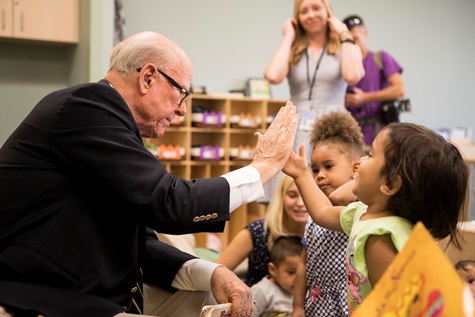When Sen. Pat Roberts sat down with preschoolers today at the Children’s Campus of Kansas City, he was focused on much more than story time and snacks. The senior senator from Kansas dropped in on the first day of school to learn more about CCKC’s model for closing the achievement gap among low-income kids—starting with a unique community facility designed specifically for young learners.
CCKC is home to three nonprofit organizations that provide a continuum of services focused on the health and wellness of children from birth to age 5. That includes nearly 150 preschool students participating in CCKC’s Educare program, which lays a strong educational foundation for children who might otherwise be derailed by the deep and lasting implications of poverty.
“I am pleased to visit Children’s Campus to see firsthand a local partnership trying new methods to teach and nurture low-income children in a facility specifically designed for their needs,” Sen. Roberts said. “These children are the most vulnerable in our society, and it is very encouraging to see a community harness the resources it has, like the University of Kansas Medical Center, LISC, Wyandotte County and other organizations by working together to meet the educational and developmental needs of at-risk children. Reading to these kids is a great way to start the day, and I hope they are off to a great start for the year.”
Funding gaps almost derailed CCKC before the first brick was laid—even though expanding access to quality early education programs and services has been a local priority, noted Heather Schrotberger, director of Project Eagle, the University of Kansas Medical Center program that operates Educare Kansas City.
“We know that quality early childhood education can make all the difference in a child’s future,” she said. “It is a powerful anti-poverty strategy. Young children flourish when we create early education settings designed for their needs, with classrooms and teachers that keep them safe and engaged. That’s why CCKC exists.”
In other words, space matters. According to a report published by the National Institute for Early Education Research, a facility’s layout, size, materials and design features can improve program quality and contribute positively to child development, while a poorly adapted and overcrowded environment undermines it. The physical configuration of early care and education spaces directly affect adult/child interaction and influence how children grow and learn.
But financing high-quality, appropriate space for young learners – much less space that can also accommodate other family services, as is the case with CCKC – is not easy. Early fundraising and philanthropic support enabled the project to secure a conventional bank loan, but CCKC still faced a significant funding gap. The project utilized the federal New Markets Tax Credit program, which is designed to encourage private-sector investment in underserved communities, to fill that critical shortfall.
CCKC highlights an important intersection between federal policy and local impact, said Matt Josephs, LISC senior vice president of policy, who joined Sen. Roberts on the CCKC tour.
“The corner of 5th St. and Minnesota Ave. might seem like it’s a long way from Washington, but federal programs like the New Markets Tax Credit have a significant local impact,” said Josephs, who also serves on the board of the New Markets Tax Credit Coalition. “CCKC is illustrative of how NMTCs can be used to deliver private sector investments into distressed neighborhoods, helping to not only provide critical services to community residents, but also to revitalize the neighborhoods and fuel further growth.”
Stephen Samuels, executive director with LISC’s Kansas City program office, noted that these kinds of investments also have significant economic benefits for the city at large. LISC helped finance CCKC as part of its comprehensive efforts to revitalize disadvantaged neighborhoods.
“CCKC allows parents to go to work without worrying if their children are in a safe, nurturing place,” he said. “It has created more than 200 jobs in a community with high poverty and unemployment rates. And, it has transformed a vacant commercial corner into an active, vibrant space,” he explained. “By connecting so many critical local partners and institutions, this facility is not only an imperative for our children; it is a significant, lasting asset for our community.”
– Story from CCKC and University of Kansas Medical Center

